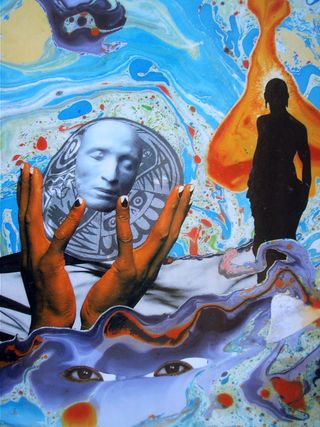

What happens when lucid dreaming is introduced to the artistic process? During my doctoral research into dream lucidity as a creative tool (Johnson, 2007), and on a personal and artistic level, I have observed that lucid dreams have enormous creative potential.
The self-reflective act of realizing “I’m dreaming this!” opens up endless possibilities for the dreamer.
People often ask: Why lucid dreams? What makes them so different from non-lucid dreams? Heightened visual perception is characteristic of lucid dreams, as shown in research studies by Green & McCreery (1994). This realism, combined with the element of conscious attention in lucid dreams, contributes to the “staying power” of the image, so that the dreamer can carry the memory of her dream images to the blank canvas, the lump of clay, or the block of wood, and convert them into art.
Studies by LaBerge (1986) and Green (1968) have shown that analytical thought in lucid dreams is characteristically high. Lucid dreamers have, as Tart points out, “awakened in terms of mental functioning within the dream world” (2000). The lucid dreamer is able to recall and carry out a predetermined task in the dream, thus facilitating in-the-dream experimentation.
Psychopathologist Chasseguet-Smirgel writes: “The process of creation [is] accompanied by the capacity to communicate with the most primitive layers of the unconscious” (1995). When this capacity to communicate includes the ability to ask the unconscious — in the form of the dreaming mind — for artistic inspiration, then the lucid dreaming artist may have a certain advantage over the non-lucid dreaming artist.
While asleep and dreaming, the artist can work uninhibitedly with new techniques and mediums, consciously seek ideas for paintings or stories, sidestep the inner critic, and work on current creative projects.
Lucid dream researchers LaBerge and Rheingold advise: “If you want to learn to paint, summon Rembrandt. Go fishing with Hemingway or Hesse and talk about that novel you’ve always wanted to write” (1990). One of my doctoral case studies, the artist Epic Dewfall, walks into art galleries in his lucid dreams and memorizes the paintings. For most lucid dreamers, keeping it simple and throwing a question such as "What shall I paint next?" into the dream environment could elicit a transformative response. When the lucid dreamer comes across an image, a tune, or a story idea that makes her itch to get creating, she can wake herself up and record it.
In lucid dreams, it’s easier to sidestep one’s inner critic than it is while awake — in one dream, I became lucid while sitting cross-legged in front of a female Buddha, and I began to draw her. In the dream, there was a woman watching me critically from the doorway, but I ignored her until she went away. Following that lucid dream, I was less critical towards my attempts at art, and this attitude freed me to experiment with different art forms.
There are different levels of dream control. My experiments combine passive and active approaches. In the passive approach, I become “just a pair of eyes” — I adopt an attitude of alert observation as dream imagery unfolds before me. Often powerful images arise from this witnessing state, which I can then incorporate into collages and fiction writing in the waking state. In the active approach, I exert my intent in the dream: I might summon a character from my novel and dialogue with them, or I might simply recall my intention to do something art-related in my lucid dream and find in doing so that the necessary materials turn up and that there’s no need or desire to influence the dream environment beyond that initial assertion of my intention.
Upon becoming lucid in a dream, we can draw a picture or announce our intention to find the “magic box” of images, ideas, and inspiration. Mine turned out to be a treasure chest lolling open behind a tree (I had to shoo away two big guard dogs to get at it), and to my surprise, it was bursting with material — scraps of silk, twines of colored wool, armfuls of slippery saris, and thick ribbons all in a sumptuous tangle. Soon after this dream, I made a collage using all of the above materials.
One thing I love about lucid dreams is that, as Kelzer observes, “lucidity does not seem to act as an inhibitor of the unconscious” (1987). Even in the most determinedly controlled lucid dream, there are always uncontrollable elements, so that the spontaneity of the dream shines through. For example, the sky turns a defiant lime-green, or a novel character melts into a puddle of warm vanilla custard.
It’s this spontaneity that gives us our most original creations, the brightest, boldest ideas to take with us back to waking reality and turn into art. Lucid dreaming seems to be a naturally creative state that can facilitate artistic endeavors irrespective of whether dream control is used, but it can also be actively drawn on to enhance the conscious performance of artistic acts such as sculpture or musical composition. In Llewellyn’s Complete Book of Lucid Dreaming, I include the account of a man who created a piano made out of light in his lucid dream. He then proceeded to compose a beautiful song on it, which he recorded when he woke up.
Pablo Picasso said: “All children are born artists. The problem is how to remain an artist as we grow up.” Well, we can practice art in our dreams, further away from our critical censor since we’re asleep, in a world where the imagination rules. In a lucid dream, we can conjure up a muse, experiment with glass-blowing, or build up an orchestra in our heads. I’ve done this before with thunderous success, despite the fact that my waking-life musical ability amounts to playing "Three Blind Mice" on the recorder when I was seven. Yet in dreams, and especially lucid ones, anything is possible!
Artistic experimentation in lucid dreams helps us to retain the spontaneity and artistic fearlessness we had when we were young children. Lucid dreaming makes it easy for us: For original art to appear before our eyes, and for us to consciously interact with that art, all we need to do is wake up inside a dream.
References
Johnson, C.R. (2007) “The Role of Lucid Dreaming in the Creative Writing Process”, Ph.D. thesis, University of Leeds, UK.
Johnson, Clare R. Llewellyn’s Complete Book of Lucid Dreaming: A Comprehensive Guide to Promote Creativity, Overcome Sleep Disturbances & Enhance Health and Wellness. Woodbury, MN: Llewellyn Worldwide, 2017.
Johnson, Clare R. Mindful Dreaming: Harness the Power of Lucid Dreaming for Happiness, Health, and Positive Change. San Francisco, CA: Conari Press, 2018.
Green, C. &McCreery, C. (1994) Lucid Dreaming: The paradox of consciousness during sleep, London, Routledge.
LaBerge, S. (1986) Lucid Dreaming, New York, Ballantine Books.
Green, C. (1968) Lucid Dreams, Oxford, Institute of Psychophysical Research.
Tart, C.T. (2000) States of Consciousness. Author’s Guild Backinprint.com Edition. Lincoln, NE, iUniverse.com, Inc.
Chasseguet-Smirgel, J. (1995) ‘“Creative Writers and Day-dreaming”: A Commentary’, in Person, E.S. Fonagy, P. &Figueira, S.A. (eds) On Freud’s “Creative Writers and Day-dreaming”, New Haven and London, Yale University Press. 107-121.
LaBerge, S. & Rheingold, H. (1990) Exploring the World of Lucid Dreaming, New York, Ballantine Books.
Kelzer, K. (1987) The Sun and the Shadow: My Experiment with Lucid Dreaming, Virginia, A.R.E Press.



